Moderate drought (D1) conditions continue to prevail across much of the southern coast of Puerto Rico, as well as the northwest coast and parts of the eastern interior. Saint Croix and Saint John are also in moderate drought, while Saint Thomas remains drought-free.
View this drought status update in Spanish.
Key Points
- Puerto Rico Conditions: Beneficial rains from Tropical Cyclones Fred and Grace were observed across the local islands with some drought improvement noticed. However, the ensuing 3 weeks have seen record to near record dryness across the island. San Juan has seen only 0.43 inches of rain in the 23-day period from August 16 to September 7, which is less than 10% of normal. This has resulted in moderate drought conditions (D1) continuing to prevail across the southern slopes, northwest, and the eastern interior. The southeast coastal plains are experiencing elevated fire risk with low fuel moisture levels, scarce rain, low humidity, and gusty wind.
- U.S Virgin Islands Conditions: Parts of the USVI are still experiencing drought. While drought conditions improved in mid-August with the passage of Tropical Cyclones Fred and Grace, the ensuing 3 weeks have seen record to near record dryness. For example, in the 23-day period from August 16 to September 7, Henry Rohlsen Airport in St. Croix only received 0.24 inches of rain, which is less than 10% of normal, and the driest such period on record. As a result, St. John and St. Croix remain in moderate drought. In addition, relatively strong winds have negatively impacted soil moisture. While also trending much drier since mid August, St. Thomas remains drought free.
- Puerto Rico Impacts: Voluntary water-use restrictions have been requested, with some water restrictions imposed in some areas. The fire danger weather in Puerto Rico continues to increase as dryness intensifies. A decreasing trend in water levels are observed at some reservoirs and aquifers across Puerto Rico.
- U.S. Virgin Islands Impacts: Very dry conditions have developed since Tropical Cyclones Fred and Grace passed south of the USVI in early to mid-August. During the first half of August, rainfall territory-wide somewhat recharged ponds and collection containers. Soil moisture increased in August, but recent persistently high wind speeds that increased evaporation rates and limited moisture recharge have reversed the improvements seen in early to mid-August. Vegetation and trees were showing signs of improvement, although dry weather has returned since mid-August. Livestock farmers are buying hay and have done so since March.
- Looking Ahead: Based on the expected and observed conditions, additional deterioration in drought conditions is possible into late September.
- For weather information specific to your area, please monitor products issued by the National Weather Service in San Juan, Puerto Rico.
U.S. Drought Monitor map for Puerto Rico, as of September 7, 2021. The U.S. Drought Monitor is updated each Thursday to show the location and intensity of drought across the country.
Nearly 32% of Puerto Rico is classified by the U.S. Drought Monitor as being Abnormally Dry (D0), while 16% of the island is classified as Moderate Drought (D1).
U.S. Drought Monitor map for the U.S. Virgin Islands, as of September 7, 2021. The U.S. Drought Monitor is updated each Thursday to show the location and intensity of drought across the country.
Moderate drought (D1) conditions are observed across Saint Croix and Saint John.
U.S. Drought Monitor Categories
U.S. Drought Monitor map for Puerto Rico, as of September 7, 2021. The U.S. Drought Monitor is updated each Thursday to show the location and intensity of drought across the country.
Nearly 32% of Puerto Rico is classified by the U.S. Drought Monitor as being Abnormally Dry (D0), while 16% of the island is classified as Moderate Drought (D1).
U.S. Drought Monitor map for the U.S. Virgin Islands, as of September 7, 2021. The U.S. Drought Monitor is updated each Thursday to show the location and intensity of drought across the country.
Moderate drought (D1) conditions are observed across Saint Croix and Saint John.
Current Conditions
Rainfall Deficits
- Puerto Rico: The 90-day rainfall deficits now range between 8 and 12 inches across the municipalities of Patillas, Guayama, and western Cayey, as well as parts of the east central interior. In contrast, the far eastern tip of the island near Fajardo as well as the west coast near Mayaguez and Aguadilla have rainfall surpluses of 6+ inches (Figure 1).
- U.S. Virgin Islands: The 90-day rainfall deficits across the U.S. Virgin Islands range from near zero in St. Thomas to about 2–3 inches in St. Croix and St. John.
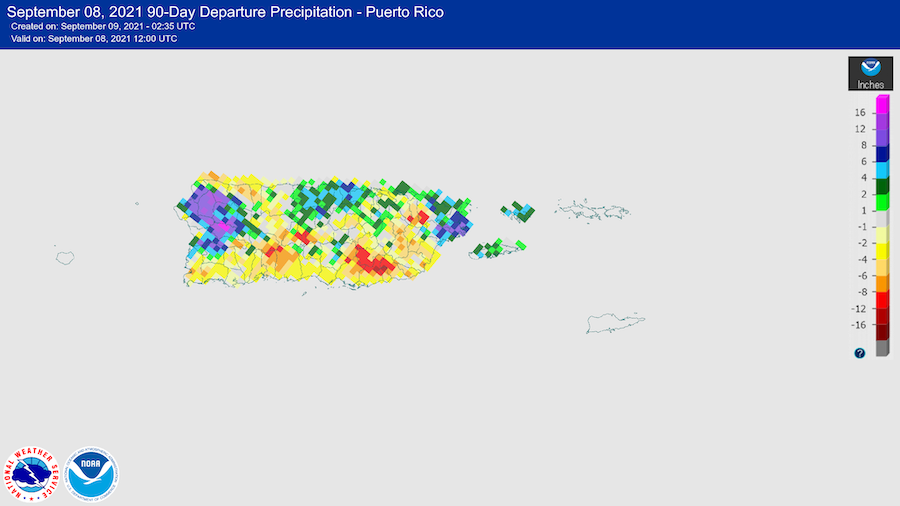
Soil Moisture Conditions in Puerto Rico
Data retrieved from the Puerto Rico Agricultural Water Management (PRAGWATER) continue to indicate dry soils across southern Puerto Rico, as well as a few spots across the eastern interior and the northern coast of the island (Figures 2 and 3).
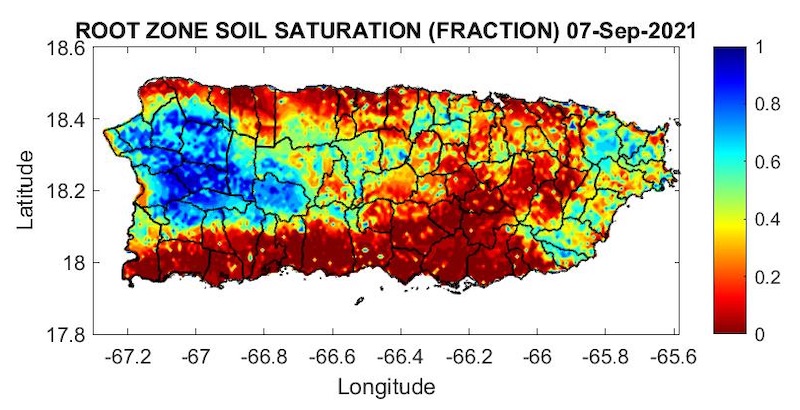
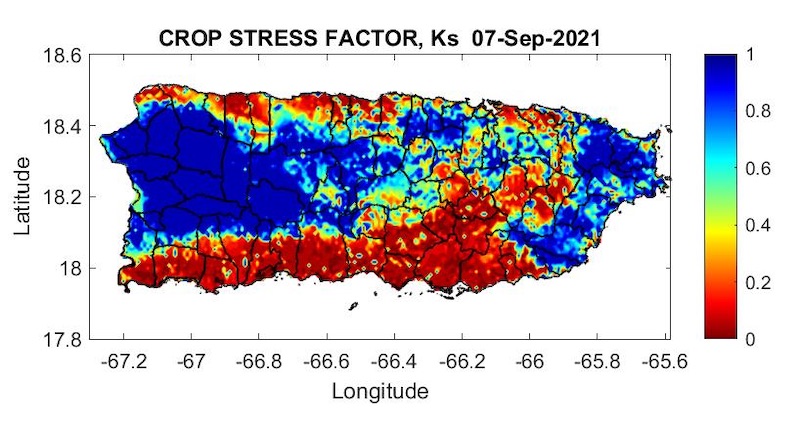
Streamflow Conditions in Puerto Rico
The 28-day average streamflow measured by the U.S. Geological Survey (USGS) gaging network shows most of the streamflows across eastern interior and central Puerto Rico running below or much below the normal range (Figure 4).
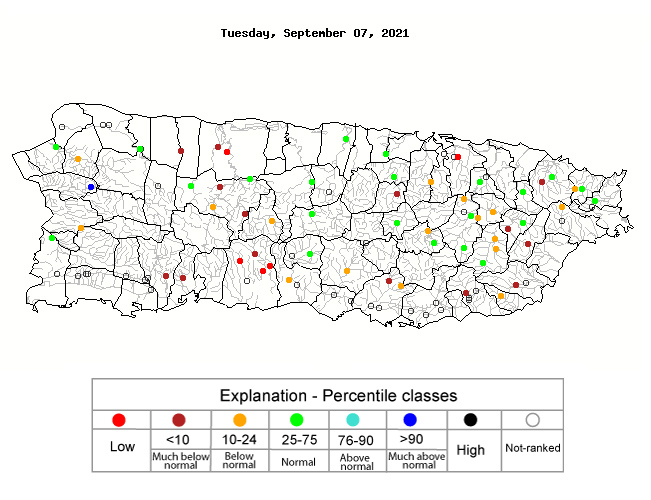
Groundwater Conditions
The groundwater levels retrieved from the USGS network indicated that most of the representative wells along the southern slopes and north-central Puerto Rico are running below or much below the normal range (Figure 5). As far as the U.S. Virgin Islands, although representative wells at Saint Thomas and Saint Croix are running at normal levels, a decreasing trend continues to prevail.
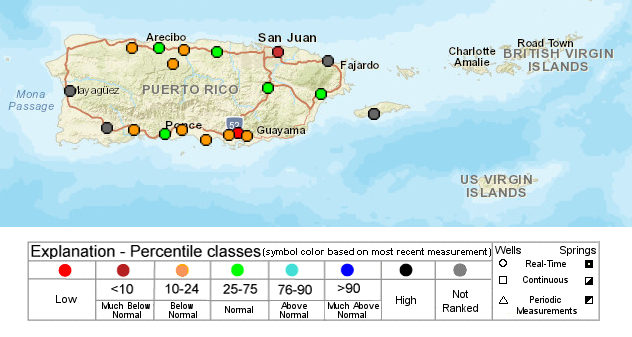
Outlooks and Impacts
Rainfall Outlook
Based on the 3-month extended forecast by the Caribbean Climate Outlook Forum (CariCOF), there is no predictability across the area. Shorter-range outlooks through mid-September show no significant changes. Longer term, forecasts continue to show an above-average probability of above-normal tropical cyclone activity in the Atlantic Basin. Therefore, based on the observed and expected conditions, additional deterioration in drought conditions is possible into late September (Figure 6).
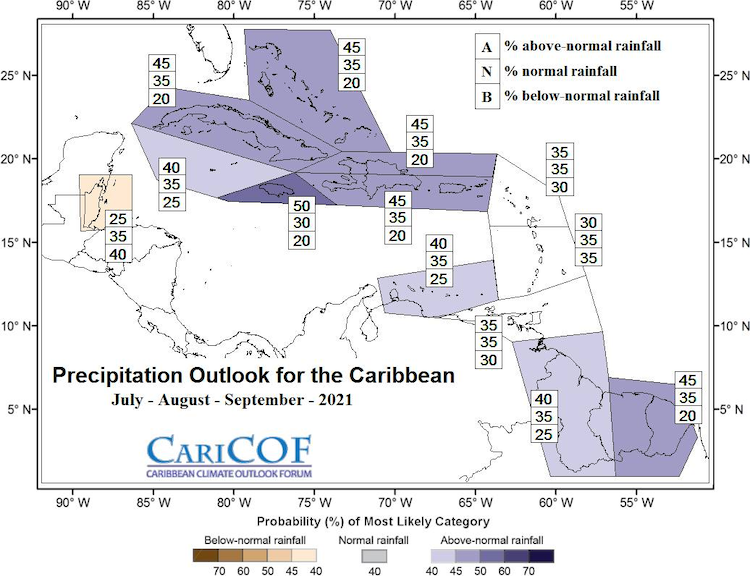
Sector Impacts
General Conditions
- Puerto Rico: There are few reports of drought impacts on agriculture and forestry sectors, with the exception of increasing fire danger in the southeast coastal plains. Cerrillos reservoir in southern Puerto Rico has been slightly affected by drought conditions.
- U.S. Virgin Islands: During August, farmers had reported signs of vegetation improving from dry and brittle to green. Since mid-August, however, the territory has experienced infrequent showers. The combination of a return to dry weather and higher-than-average winds has not allowed soil to retain moisture as it should this time of year. Since drought conditions continue in many areas, livestock farmers are still planning mitigation efforts to feed livestock, and the VI Department of Agriculture (VIDA) has ordered hay as farmers reported not having enough. More than three dozen USVI livestock producers, mainly on St. Croix, have applied for assistance through USDA’s Livestock Forage Disaster Program, which was activated earlier this year by an extended period of D2, or severe drought.
Agricultural Conditions
- Puerto Rico: Conditions are generally favorable with relatively mild to drought conditions limited to some regions. However, lower than normal rainfall in the upcoming, typically rainy, months may lead to increased water scarcity. A farmer in southeastern Puerto Rico reports that it has not rained for weeks, which has caused the pastures to dry out and has forced increased irrigation of crops. Farmers in the island municipality of Vieques also report a decrease in rainfall over the past month and have had to irrigate crops with water from ponds.
- St. Thomas: Farmers are reporting intermittent and sporadic rain, and trees and vegetation are slowly responding. Poultry farmers who have had access to little or no grass are reporting a slight rise in grass and related vegetation for feed, but hot, dry weather is still impacting overall production. Water conservation methods are still in place at this time.
- St. John: Farmers are reporting that rain has quelled drought conditions, but it is still sporadic. Vegetation is slowly rebounding, but soil is not retaining moisture due to high winds. Farmers are also continuing conservation practices, and have adapted their methods; they regulate irrigation practices in early morning and late afternoon to maximize water resources.
- St. Croix: Drought conditions remain. While some rain fell, farmers of all sizes are reporting that intermittent high temperatures and windy conditions affect their ability to retain soil moisture and water. VIDA also reported that on St. Croix, water deliveries to the agricultural community included more than 1,098,110 gallons in July, and in August water deliveries were listed as 1,567,990 gallons. One large producer reported increases from purchasing 8,000 gallons of water per week to 12,000 gallons per week. Livestock farmers on St. Croix are also still seeking to purchase feed as chop as it is mildly available, and those seeking cut and carry to offset feed are concerned about purchasing hay. This is creating an underlying need for additional irrigation systems in their fields. Poultry farmers are reporting increased water in cisterns. As a result, they are experiencing an increase in egg production, which was impacted by extreme heat and drought.
Forest and Fire Conditions
- Little rain, low humidity, and dry fuels along the Puerto Rico south-central coastal plain have increased fire risk in the Salinas area. Open shrublands and grasslands on the south-facing slopes in this area are those most susceptible to fire.
For More Information
- National Weather Service (NWS) Weather Forecast Office – San Juan: Climate and Drought Information
- NWS Drought Information Statements for Puerto Rico and the U.S. Caribbean
- Drought.gov:
- Caribbean Drought Bulletins. Caribbean Regional Climate Center, Caribbean Institute for Meteorology and Hydrology (CIMH), Barbados
- U.S. Department of Agriculture (USDA) Caribbean Climate Hub drought and disaster assistance resources for tropical forestry and agriculture
Prepared By
Odalys Martinez
Senior Service Hydrologist, NWS Weather Forecast Office – San Juan
Meredith Muth
NOAA/National Integrated Drought Information System (NIDIS)
Victor Murphy
Climate Services Program Manager, National Weather Service Southern Region
Christina Chanes, Gregory Guannel
University of the Virgin Islands
William Gould, Nora Álvarez-Berríos, and Eva Holupchinski
USDA Caribbean Climate Hub, USFS International Institute of Tropical Forestry
Puerto Rico Reporting Input: Thanks to the Agricultural Extension Service, College of Agricultural Sciences, University of Puerto Rico-Mayaguez. Thanks to Betzaida Ortíz Carrión, Ana Elisa Quintero from La Colmena Cimarrona, Finca Atabey, and Eric Harmsen, Professor of Agricultural Engineering UPR.
USVI Reporting Input: Several individuals contributed to this report and we are acknowledging the following for their support including the faculty, staff and collaborators of the UVI School of Agriculture, Cooperative Extension, UVI Physics Program, UVI Etelman Observatory, UVI Agricultural Experiment Station, VI Department of Agriculture, UVI Caribbean Green Technology Center, as well as the USDA Office Chief Economist, National Parks Service in St. Croix, USDA Farm Service Agency, Coral Bay Community Council and the many volunteers, drought reporters and farmers from across the territory.
About This Report
This drought update is issued in partnership between the National Integrated Drought Information System (NIDIS), National Oceanic and Atmospheric Administration (NOAA) National Weather Service, the U.S. Department of Agriculture (USDA), and the University of the Virgin Islands. The purpose of the update is to communicate a potential area of concern for drought expansion and/or development within Puerto Rico and the U.S. Virgin Islands based on recent conditions and the upcoming three-month forecast.
NIDIS and its partners will issue these updates every two months. Subscribe for these U.S. Caribbean drought updates here.





